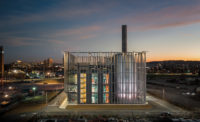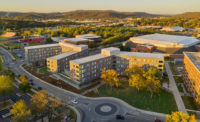The building and construction technology (BCT) program at the University of Massachusetts Amherst has built a reputation on its research of innovative wood-construction technologies. So when the school announced a plan to bring under one roof all its design disciplines—BCT, architecture, and landscape architecture and regional planning—the faculty seized the opportunity to put its academic work into practice. The result is the recently completed 87,500-square-foot Design Building. Created by Boston-based Leers Weinzapfel Associates (LWA), the structure is not only the first academic facility to be made of engineered cross-laminated timber (CLT), an environmentally friendly super- plywood developed as an alternative to stone, masonry, concrete, and steel. It also is the first building in the United States to use a composite flooring system made of cast-in-place concrete and CLT.
“Many people think of wood as just an old material,” says BCT program director Alex Schreyer. “Our group wanted to show how we could work with it in contemporary terms.” To that end, LWA demonstrated CLT’s ability to handle horizontal and vertical loads by utilizing the material for the building’s exposed glulam frame as well as on the various shaft walls for the stairs, elevator tower, and mechanical systems. In the two-story atrium, where exposed CLT panels span up to 65 feet in an open common area, the architects pushed the material further: They collaborated with engineering firm Equilibrium Consulting on an innovative “zipper” truss system of glulam beams and steel rods that would support the CLT-concrete composite floor above and the weight of the building’s green roof.
“All the members of the seven trusses converge at a single midpoint like a closed zipper,” says LWA principal Tom Chung, “hence the terminology.” Aside from their visual impact, he explains, the trusses are more materially efficient than thick steel or wood options. They also eliminate the need for vertical supports. “We probably cut the number of beams required in a steel structure by half,” he adds.
The finished form departs from the expected, both inside and out. “Most mass-timber buildings in the United States have been basically rectangular boxes,” says Chung. By contrast, the Design Building has a cantilevered entryway and, in response to a sloping site, stands four stories on its downhill side and three on the uphill side.
Although the use of CLT makes a substantial contribution, it is just one of the building’s green features. For example, LWA maximized natural light by adding glass fronts to the structure’s office spaces, which wrap around an outdoor courtyard that doubles as an open-air classroom. The firm also placed skylights in the ceiling of the lower floor to draw light into the building’s interior. The architects minimized solar heat gain through the calculated placement and size of windows as well as by specifying self-shading electrochromic glass, which tints in response to direct light, on the south-and west-facing curtain walls.
The building’s high-performance envelope has two-part insulation: mineral wool along the outside of the sheeting and behind the rainscreen, plus staple insulation in the cavities of the metal-stud drywall backup assembly. In addition, LWA broke up the mechanicals into zones. Four air-handling systems serve their respective areas so that heating and cooling aren’t wasted on empty space. Radiant heat on the ground floor and chilled beams throughout the building increase the energy savings.
Finally, in the upstairs exterior courtyard, integrated landscaping by local studio Stephen Stimson Associates includes a stormwater management system that directs roof runoff to a series of bioswales. Principal Lauren Stimson says her team opted for native mosses, ferns, young spruces, and evergreens instead of the standard sedum which, although drought-resistant, “doesn’t feel like New England.” The structure’s green roof reduces the heat island effect and slows stormwater runoff.
UMass Amherst’s design departments hope their new building will encourage CLT construction to take greater hold in the United States. One hindrance to the material’s adoption, the architects say, is that utilizing it requires a special permitting process. The designers also had to correct the misconception that heavy timber is less fire-resistant than steel.
In the case of the Design Building, it might have taken extra effort to use CLT, but the result satisfies the design faculty’s goal of showcasing a large-scale application of its research. “It demonstrates this sustainable technology is feasible and cost-efficient,” says Schreyer. In fact, the $52 million Design Building—which is aiming for LEED Gold certification—is one of those rare instances of innovation coming in on budget.










